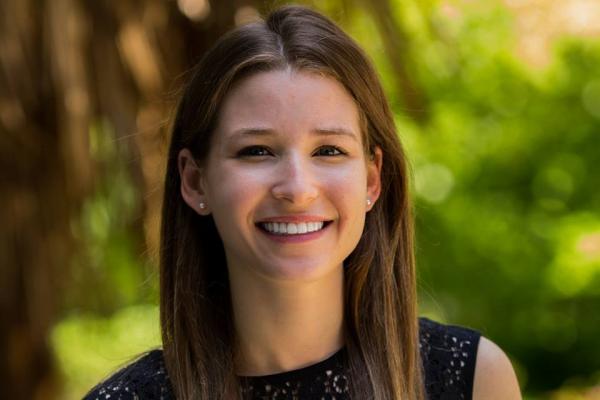At just 11 years old, Jessilyn Dunn was determined to learn more about the heart. After being by her grandmother’s side for her second heart valve replacement surgery, Dunn became frustrated at the lack of a permanent fix for her grandmother’s condition.
She began to study vascular aging, and found a passion that would chart the course for her entire academic career. Dunn obtained her B.S. in Biomedical Engineering from Johns Hopkins University, and today is a 5th year Ph.D. student at the Georgia Institute of Technology and Emory University. She’s working to better understand cardiovascular disease–the same condition that affects her grandmother.
“Cardiovascular disease continues to be the number one cause of death in the developed world, despite major advancements in medicine,” said Dunn. “I study how blood flow affects gene expression, which will either prevent or accelerate harmful plaque buildup that leads to heart disease.”
Dunn’s know-how in the lab is rivaled only by her exceptional skills as a multi-tasker. She spent time this past summer interning at the CDC through the strategy and technology consulting firm Booz Allen Hamilton, and now continues working as a graduate research fellow in the Jo Lab of Vascular Mechanobiology and Disease. It’s here that her abilities as a researcher shine. Dunn’s thesis centers around a genome-wide analysis of gene expression and DNA methylation in cardiovascular disease.
“Put simply,” Dunn explained, “the genome is like a puzzle where the pieces are constantly changing. When one piece changes, the surrounding pieces must alter their behavior in response. I find it fascinating to learn why and how this happens.”
Her fascination is what drives her, and gets results. Dunn’s thesis culminated in a May 2014 publication in the Journal of Clinical Investigation–one of five published studies Dunn has under her belt.
But Dunn’s success hasn’t come without its fair share of challenges. Early on, she faced gender bias in a field that’s still predominantly ruled by men. She found solace in supportive groups like MIT’s Women’s Technology Program and the Society of Women Engineers.
“These groups taught me about reducing gender discrimination that still persists in the field, and how to be a role model for young women in science,” Dunn said.
It’s a role Dunn doesn’t take lightly. While on the BBUGS Education and Outreach Committee, she helped organize a program to introduce biomedical engineering to 8th grade girls from the Bronx Preparatory Middle School in New York. The girls took basic biology lessons learned in the classroom and applied them to form hypotheses about sets of research. Dunn hopes programs like this will inspire and encourage young girls to pursue STEM fields–science, technology, engineering and mathematics.
“These young women truly represent the next generation of researchers in biomedical engineering,” Dunn said. “In several years, one of these girls could be working right here in this lab–with even more advanced technology and equipment.”
Dunn credits Georgia Tech’s Biomedical Engineering Department with helping her achieve her research goals, providing the computational infrastructure to perform large-scale analyses of data sets. Down the road, she hopes to pursue a career converting and translating biomedical “big data” into real and impactful conclusions.
“Georgia Tech has introduced me to a wide variety of research fields that I otherwise would have known nothing about,” Dunn said. “The faculty have helped me take the interest that I had when I was younger and turn it into a real, concrete career path doing something that I believe in.”
Listening to Dunn describe her ambitious goals in the biomedical engineering arena, you might not guess that she pursues another passion: ballet dancing. Not only does she find the time to practice ballet regularly, but she also founded the Johns Hopkins University Ballet Company during her time as an undergrad there. The Company holds free classes and performances for the Baltimore community and teaches ballet at public elementary schools.
It’s all part of Dunn’s larger mission to instill young girls with a clear and strong message: you can succeed at whatever you put your mind to, and you can excel at many different things if you simply take the chance to try.
“In biomedical engineering, in dance and in life, your strongest proponent is yourself,” Dunn said. “It can be difficult to challenge longstanding beliefs or do something that has never been done before, but it’s only through doing this that you achieve enormous success.”
Of that, Dunn is living proof.
Connect with Jessilyn Dunn on LinkedIn
Follow Jessilyn Dunn on Google Scholar
Written by Chris Calleri
Media Contact
Chris Calleri
Communications Manager
Wallace H. Coulter Department of Biomedical Engineering
Georgia Institute of Technology & Emory School of Medicine
313 Ferst Drive, Suite 2120
Atlanta, GA 30332-0535
Phone: 404.385.2416
Keywords
Latest BME News
Jo honored for his impact on science and mentorship
The department rises to the top in biomedical engineering programs for undergraduate education.
Commercialization program in Coulter BME announces project teams who will receive support to get their research to market.
Courses in the Wallace H. Coulter Department of Biomedical Engineering are being reformatted to incorporate AI and machine learning so students are prepared for a data-driven biotech sector.
Influenced by her mother's journey in engineering, Sriya Surapaneni hopes to inspire other young women in the field.
Coulter BME Professor Earns Tenure, Eyes Future of Innovation in Health and Medicine
The grant will fund the development of cutting-edge technology that could detect colorectal cancer through a simple breath test
The surgical support device landed Coulter BME its 4th consecutive win for the College of Engineering competition.








